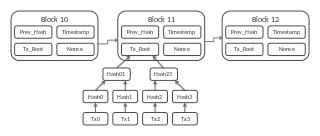A smart contract is a computer protocol intended to digitally facilitate, verify, or enforce the negotiation or performance of a contract. Smart contracts allow the performance of credible transactions without third parties. These transactions are trackable and irreversible.
Zerocoin is a privacy protocol proposed by Johns Hopkins University professor Matthew D. Green and his graduate students in 2013 as an extension to the Bitcoin protocol that would improve Bitcoin transactions' anonymity.

Primecoin is a cryptocurrency that implements a proof-of-work system that searches for chains of prime numbers.

Vitaly Dmitriyevich "Vitalik" Buterin is a Russian-Canadian programmer and writer primarily known as a co-founder of Ethereum and as a co-founder of Bitcoin Magazine.
Ethereum is an open-source, public, blockchain-based distributed computing platform and operating system featuring smart contract (scripting) functionality. It supports a modified version of Nakamoto consensus via transaction-based state transitions.

A blockchain, originally block chain, is a growing list of records, called blocks, which are linked using cryptography. Each block contains a cryptographic hash of the previous block, a timestamp, and transaction data.
A distributed ledger is a consensus of replicated, shared, and synchronized digital data geographically spread across multiple sites, countries, or institutions. There is no central administrator or centralized data storage.
Proof-of-space (PoSpace), also called Proof-of-capacity (PoC), is a means of showing that one has a legitimate interest in a service by allocating a non-trivial amount of memory or disk space to solve a challenge presented by the service provider. The concept was formulated by Dziembowski et al. in 2015 and with a different formal definition by Ateniese et al. in 2014.

The bitcoin scalability problem refers to the discussion concerning the limits on the amount of transactions the bitcoin network can process. It is related to the fact that records in the bitcoin blockchain are limited in size and frequency.
Nuco Inc. is the developer of the Nuco enterprise blockchain platform and a founding member and director of the Enterprise Ethereum Alliance. It is headquartered in Toronto, Ontario. It is backed by Bessemer Venture Partners.
Ethash is the proof-of-work function in Ethereum-based blockchain currencies. It uses Keccak, a hash function eventually standardized to SHA-3. These two are different, and should not be confused. Since version 1.0, Ethash has been designed to be ASIC-resistant via memory-hardness and easily verifiable. It also uses a slightly modified version of earlier Dagger and Hashimoto hashes to remove computational overhead. Previously referred to as Dagger-Hashimoto, the Ethash function has evolved over time. Ethash uses an initial 1 GB dataset known as the Ethash DAG and a 16 MB cache for light clients to hold. These are regenerated every 30,000 blocks, known as an epoch. Miners grab slices of the DAG to generate mix-hashes using transaction and receipt data, along with a cryptographic nonce to generate a hash below a dynamic target difficulty.

STEEM is a cryptocurrency based on the social media and content-focused Steem blockchain, which was created on March 24, 2016 by Ned Scott and the blockchain developer Dan Larimer. In terms of total market capitalization, STEEM is currently ranked at place 40. with a market capitalization of more than 159 million USD..
EOS.IO is a blockchain protocol powered by the native cryptocurrency EOS. The protocol emulates most of the attributes of a real computer including hardware with the computing resources distributed equally among EOS cryptocurrency holders. EOSIO operates as a smart contract platform and decentralized operating system intended for the deployment of industrial-scale decentralized applications through a decentralized autonomous corporation model. The smart contract platform claims to eliminate transaction fees and also conduct millions of transactions per second.
Proof-of-authority (PoA) is an algorithm used with blockchains that delivers comparatively fast transactions through a consensus mechanism based on identity as a stake.
In blockchain, a fork is defined variously as:
Daniel Larimer is a software programmer and cryptocurrency entrepreneur. Larimer created the cryptocurrency platform BitShares, co-founded the blockchain Steem, and is currently CTO of Block.one, a company involved with the development of EOS. Larimer was also the creator of the DPOS consensus algorithm and Graphene technology. In February 2018, Forbes estimated Larimer's net worth between $600 to $700 million.
There are various different types of blockchain networks. Including but not limited to public, private and consortium blockchains. A hybrid blockchain solution is often used where multiple parties, trust, data access management and sharing, friction, regulations and a combination of centralization and decentralization is involved. A hybrid blockchain is also used by entities that need the benefits of both the public and private characteristics, which can be achieved using Interchain, bridges or other interoperability solutions between legacy systems and blockchains, both public or private.






